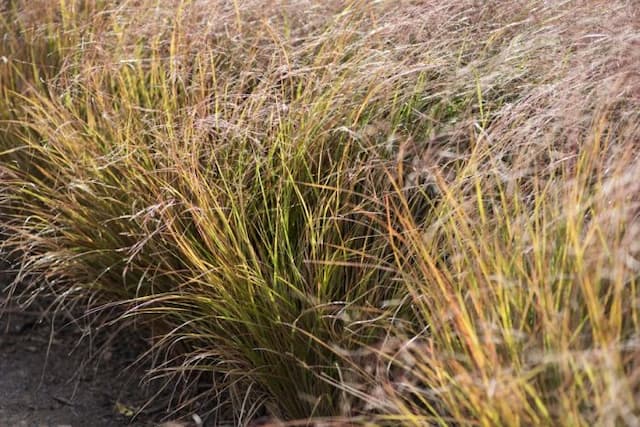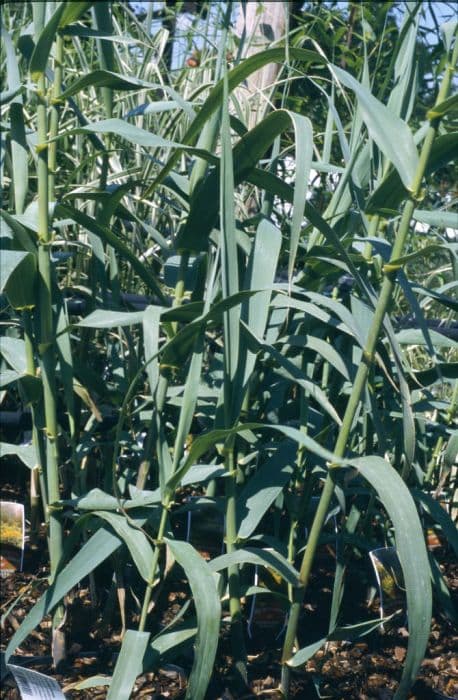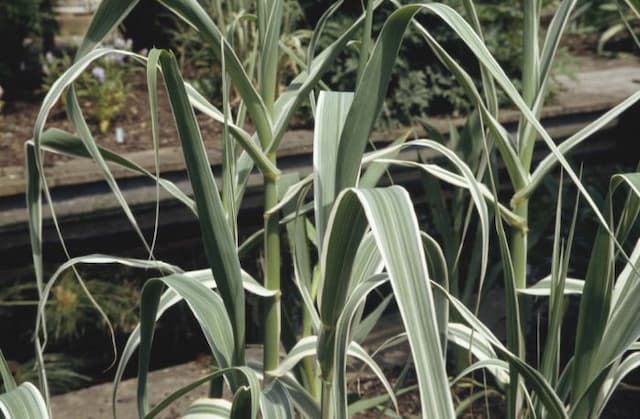Switchgrass Panicum virgatum 'Dallas Blues'











ABOUT
'Dallas Blues' is a variety of switchgrass known for its striking appearance. It possesses broad, blue-green leaves which can offer a metallic hue in the sunlight, setting it apart from many other ornamental grasses. These leaves are long, tapering, and have a slightly rough texture to the touch, showcasing a great visual interest throughout the seasons. The plant carries itself with an upright and robust posture, and as the seasons progress, the foliage can transition into an attractive display of warm hues ranging from deep purples to reds. Come late summer and early fall, 'Dallas Blues' produces feathery flower panicles. These delicate blooms are initially a light pink to silver color and are held high above the foliage, creating a soft, airy effect. As the seeds mature, these plumes can evolve into a tan shade, providing a beautiful contrast against the colorful leaves. The seed heads persist well into winter, adding texture and interest to the garden even in the colder months. Overall, 'Dallas Blues' switchgrass presents a blend of striking blue-green foliage with robust and tall flower spikes that contribute to its popularity as an ornamental plant, offering multi-seasonal appeal.
About this plant
 Names
NamesFamily
Poaceae
Synonyms
Switchgrass, Dallas Blues Switchgrass
Common names
Panicum virgatum 'Dallas Blues'.
 Toxicity
ToxicityTo humans
Switchgrass is generally not considered toxic to humans. There is no widespread documentation of poisoning or severe adverse effects from ingesting this plant. However, as with many plants, individual allergies or sensitivities may exist, and caution should be exercised. It is always advisable to avoid ingesting plants not specifically grown for consumption.
To pets
Switchgrass is also generally recognized as non-toxic to pets. It is not known to contain any substances that are harmful to dogs, cats, or other domestic animals if ingested. However, it is important to note that the ingestion of any plant material may cause gastrointestinal irritation or upset in some pets, so monitoring for signs of digestive distress is prudent if a pet consumes this plant.
 Characteristics
CharacteristicsLife cycle
Perennials
Foliage type
Deciduous
Color of leaves
Blue-green
Flower color
Pink
Height
4-6 feet (1.2-1.8 meters)
Spread
2-3 feet (0.6-0.9 meters)
Plant type
Herb
Hardiness zones
4-9
Native area
North America
Benefits
 General Benefits
General Benefits- Ornamental Appeal: Provides striking blue-green foliage and purplish-pink flower spikes that add aesthetic value to landscapes.
- Drought Tolerance: Once established, requires minimal watering, making it suitable for xeriscaping and water-wise gardens.
- Erosion Control: Deep root system helps stabilize soil and prevent erosion on slopes and in other vulnerable areas.
- Wildlife Habitat: Attracts birds and beneficial insects, which helps maintain ecological balance in the garden.
- Low Maintenance: Requires little care once established, with no need for fertilizers or pesticides.
- Winter Interest: Retains structure and color in winter, providing visual interest throughout the year.
- Adaptability: Thrives in a variety of soil conditions, from dry to moist, and is tolerant of heat and humidity.
- Privacy Screen: Tall, dense growth habit is ideal for creating natural privacy screens or living fences.
- Native Plant: As a North American native, it supports local ecosystems and is well-adapted to regional climates.
 Medical Properties
Medical PropertiesThis plant is not used for medical purposes.
 Air-purifying Qualities
Air-purifying QualitiesThis plant is not specifically known for air purifying qualities.
 Other Uses
Other Uses- Panicum virgatum 'Dallas Blues', commonly known as switchgrass, can be used as a natural dye source; the leaves and stems impart colors to fabrics when properly treated.
- Switchgrass biomass can be converted into bio-oil through fast pyrolysis, providing an alternative to fossil fuels for energy production.
- The fibrous nature of switchgrass can be utilized in making paper or cardboard, offering a sustainable raw material that is both renewable and biodegradable.
- In some regions, switchgrass is used as a thatching material for traditional roofing due to its long, strong blades.
- Switchgrass can be used in weaving to create baskets, mats, and other handicrafts because of its pliable stems when young and dried.
- The dense growth of switchgrass provides a habitat for beneficial insects and spiders that act as natural pest control in gardens and farms.
- Switchgrass is incorporated in biodegradable plant pots that decompose and enrich the soil as the plant grows.
- As an ornamental grass in landscaping, switchgrass can be effective for erosion control on slopes and banks, helping to stabilize soil and prevent runoff.
- The seeds of switchgrass are often used in birdseed mixtures, providing a natural and nutritious food source for various bird species.
- Switchgrass is planted in constructed wetlands for wastewater treatment, utilizing its root system to filter contaminants and improve water quality.
Interesting Facts
 Feng Shui
Feng ShuiThe Switchgrass is not used in Feng Shui practice.
 Zodiac Sign Compitability
Zodiac Sign CompitabilityThe Switchgrass is not used in astrology practice.
 Plant Symbolism
Plant Symbolism- Resilience: Also known as Switchgrass, Panicum virgatum 'Dallas Blues' is a hardy plant that can thrive in challenging conditions, symbolizing the ability to withstand adversity and bounce back from difficulties.
- Adaptability: Switchgrass is known for its adaptability to different environments, representing flexibility and the willingness to adjust to new situations.
- Sustainability: Due to its use in biofuel production and ecological restoration, Switchgrass symbolizes sustainable practices and environmental stewardship.
- Growth: As a fast-growing grass, it embodies growth, development, and the continuous pursuit of personal improvement.
 Water
WaterDallas Blues Switchgrass should be watered deeply about once weekly, providing it with approximately 1 inch of water each time. This deep watering encourages a robust root system. During hot, dry periods, you may need to water twice a week. Make sure to allow the soil to dry out between watering sessions to avoid waterlogging. Newly planted grasses will require more frequent watering until they are established. Overwatering is a common mistake; despite this plant's love for moisture, it's drought-tolerant once established, requiring less frequent watering.
 Light
LightDallas Blues Switchgrass prefers full sun conditions to thrive, which means it needs at least six hours of direct sunlight each day. The best spot for planting is an area with unfiltered sunlight. Partial shade is also tolerable, but the plant may not grow as vigorously or develop as full a foliage.
 Temperature
TemperatureDallas Blues Switchgrass is hardy and adaptable, able to tolerate temperatures down to about -20 degrees Fahrenheit, making it suitable for many climates. The ideal temperature range for optimal growth is between 75 and 90 degrees Fahrenheit. It can withstand high summer temperatures and is generally unfazed by the heat when established.
 Pruning
PruningPrune Dallas Blues Switchgrass back to about 4 inches above ground level in late winter or early spring before new growth starts. This helps to maintain a tidy appearance and stimulates healthy new growth. Pruning yearly also allows sunlight to reach the base of the plant, which promotes robust development.
 Cleaning
CleaningAs needed
 Soil
SoilSwitchgrass 'Dallas Blues' thrives in well-draining soil with a pH range of 4.5 to 7.4. An ideal soil mix includes loam, sand, and organic compost to provide nutrients and proper drainage.
 Repotting
RepottingSwitchgrass 'Dallas Blues' is a perennial grass that typically does not require repotting as it is commonly grown outdoors and can spread through its rhizomes.
 Humidity & Misting
Humidity & MistingSwitchgrass 'Dallas Blues' is tolerant of a wide range of humidity levels and does not require specific humidity conditions to thrive.
 Suitable locations
Suitable locationsIndoor
Provide full light, don't overwater, and ensure good air circulation.
Outdoor
Plant in full sun, well-draining soil, and space adequately.
Hardiness zone
4-9 USDA
 Life cycle
Life cyclePanicum virgatum 'Dallas Blues', commonly known as switchgrass, begins its life cycle as a seed, which, when conditions are right—typically in late spring or early summer—germinates in the soil. The seedling emerges and establishes a root system while developing its first shoots and leaves. As the plant grows, it enters a vegetative state where it focuses on leaf and stem growth, forming clumps with bluish-green foliage. Throughout the summer, switchgrass transitions into reproductive maturity, producing tall, airy panicles of flowers that can range in color from reddish-purple to silver. These flowers are pollinated by the wind, leading to seed set, and by late fall, the plant produces seeds that drop to the ground or are carried away to potentially germinate new plants. Finally, in winter, switchgrass enters dormancy, with above-ground parts dying back while the root system remains alive to restart the cycle in the next growing season.
 Propogation
PropogationPropogation time
Spring-Early Summer
Panicum virgatum 'Dallas Blues', commonly known as Dallas Blues switchgrass, can be propagated through division. The optimal time for dividing this grass is in the early spring before the new growth begins or in the late fall after the growing season has ended. To propagate by division, carefully dig up an established clump of Dallas Blues switchgrass and use a sharp spade or knife to cut through the root ball, creating smaller divisions with several shoots and a portion of the root system attached. These divisions should then be immediately replanted into prepared soil, maintaining the same planting depth as the original plant. It is important to water the new divisions well to help establish them. Division allows gardeners to maintain the health of their switchgrass clumps and provides new plants that are genetically identical to the parent plant.









